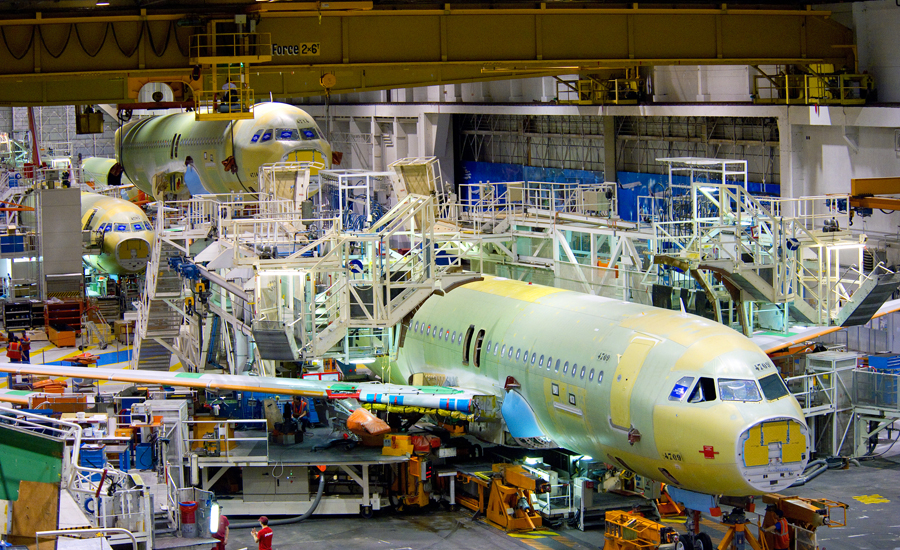SOURCE: SATYAJEET KUMAR/ FOR MY TAKE / IDRW.ORG

Modi government is trying to nudge Global Airline manufacturers like Airbus and Boeing to set up local final assembly lines for some of the popular narrow-body aircraft considering that both have predicted sales of over 2000 aircraft to India in the next 20 years.
The Indian commercial aviation industry has made significant strides in recent years, but with the development of indigenous aircraft, it remained a cash cow for Airbus and Boeing which simply is just interested in selling aircraft and throwing crumbles in name of localization of components for their global supply chain that contribute minuscule to the Indian economy.
One of the areas that India is lacking is why Global Players like Boeing and Airbus will never want to move any of their final assembly lines to India because, unlike China, India doesn’t have any other option but to buy from them. India’s efforts to develop local small-haul or medium-haul passenger aircraft have been miserable and One of the most notable examples was a lack of trust in the Regional Transport Aircraft (RTA) program that was proposed by the CSIR-NAL along with other Indian aerospace companies like Hindustan Aeronautics Limited (HAL).
Indian companies lack experience and foreign companies have no obligation to set up final assembly plans in India due to the lack of any local competition in the market so it’s a win-win situation for them and India will end up burning nearly $200 billion in the next 20 years procuring this jets largely fuelled by Indian Private Airline sector companies that are expanding their fleet.
India needs to get its basic right and cant depend on Sarkari Aerospace companies that have no experience nor any manpower resources to work on commercial planes of such a magnitude.
But there are several steps that India can take to develop its commercial passenger planes:
- Investment in Research and Development: India needs to invest heavily in research and development to develop advanced technologies for commercial passenger planes. This includes developing new materials, propulsion systems, and avionics that will make the planes more fuel efficient, reliable, and safer.
- Building a Skilled Workforce: India needs to build a skilled workforce that has the knowledge and expertise to design, develop and manufacture commercial passenger planes. This includes training engineers, technicians, and other professionals in the aerospace industry.
- Collaboration and Partnership: India can collaborate and partner with other countries and companies to gain access to the latest technologies and expertise. This can include joint ventures, technology transfer agreements, and strategic partnerships.
- Government Support: The Indian government needs to provide support to the aerospace industry through funding, tax breaks, and other incentives. This will help to attract investment, and encourage companies to invest in the development of commercial passenger planes.
- Developing Infrastructure: India needs to develop the necessary infrastructure to support the aerospace industry. This includes building and maintaining airports, aircraft manufacturing facilities, and testing and certification centres.
- Focusing on the domestic market: India has a large population and a growing middle class, which creates a huge domestic market for commercial passenger planes. Indian companies need to focus on this market and develop planes that cater to the specific needs of the Indian market.
- Long-term vision: The development of a commercial passenger plane is a long-term vision and requires a significant investment of time, money, and resources. Therefore, Indian companies need to have a long-term vision and be willing to make the necessary investment to make it happen.
Overall, developing a commercial passenger plane requires a combination of investment in R&D, building a skilled workforce, collaboration and partnerships, government support, developing infrastructure, focusing on the domestic market and having a long-term vision. With these steps, India can successfully develop its commercial passenger planes and become a major player in the global aerospace industry.
Disclaimer : Articles published under ” MY TAKE ” are articles written by Guest Writers and Opinions expressed within this article are the personal opinions of the author. IDRW.ORG is not responsible for the accuracy, completeness, suitability, or validity of any information on this article. All information is provided on an as-is basis. The information, facts or opinions appearing in the article do not reflect the views of IDRW.ORG and IDRW.ORG does not assume any responsibility or liability for the same. article is for information purposes only and not intended to constitute professional advice .
Article by SATYAJEET KUMAR , cannot be republished Partially or Full without consent from Writer or idrw.org